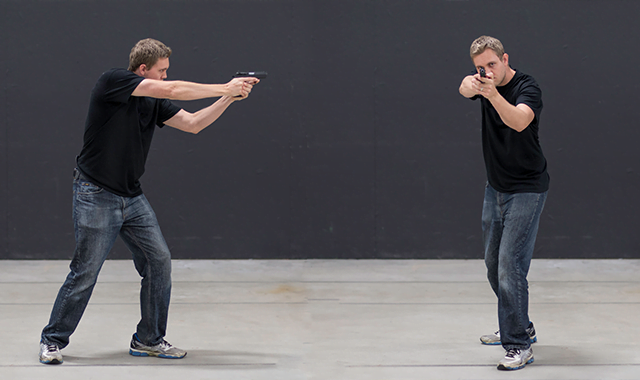Whether you have just picked up shooting or you have been shooting for a while now but are not satisfied with your results, this article is for you.
Here we will walk you through five tips, with detailed explanations that will help you increase your shooting accuracy.
1. Improve your stance
2. Concentrate on breathing
3. Practice ’til perfection
4. Master the trigger control
5. Try not to flinch
1. Improve your stance
Stance is the foundation of accuracy in shooting. How you adjust your stance will depend on the type of weapon you are shooting from.
Shotgun
For effective shotgun shooting, you need quick reflexes and flexibility. This is important because, most of the time, you will shoot at a moving target from a standing position.

Try spreading your feet at about shoulder-width with the knees slightly bent to achieve the perfect balance. Put your left foot a bit forward (if right-handed) and angle your body in the same direction. Adjust the toes of your left foot at about 45 degrees towards the target.
This stance adjustment will allow you to swing better with your target while maintaining control over your shot.
Handgun
Handgun shooting also requires a stable body position. The three main handgun stances are Isosceles, Weaver, and Tactical.
Isosceles

Position yourself to face the target in the straight line and spread your feet at a shoulder-width with the toes aligned. Lean your waist towards the target and extend your arms to form an isosceles triangle.
Weaver

Place your left foot ahead (if right-handed) while your right foot is angled to approximately 45 degrees to the side. Slightly bend your left knee while keeping your right leg straight. Lean your torso forward and align your shoulders with your left foot.
Tactical

Align your body with the target and spread your legs at shoulder-width. Put your right foot (if right-handed) slightly behind your left foot while bending your knees a little.
Rifle
The five most common rifle shooting stances are Prone, Kneeling, Sitting, and Standing.
Prone 
Lie on your stomach and plant your left elbow (if right-handed). Place your gunstock on your cheek and your right elbow on the ground. The prone stance is the most stable and accurate one, but it takes more time to assume.
Kneeling

Place your right knee (if right-handed) on the ground while your left leg is positioned to support your right-hand elbow. Don’t put your elbow on the kneecap as your hand will not be stable enough; instead, place it on the leg’s muscles.
Sitting

Support both arms with your legs and make sure your elbows are not in contact with your knee caps.
Standing

Stand vertical to the target with your feet spread at approximately shoulder-width. Your left hand (if right-handed) will be holding the forestock with the elbow pointing down. Hold the grip with your right hand with your elbow pointing slightly out and rest the gunstock against your shoulder.
2. Concentrate on breathing
Your shoulders, abdomen, and chest all move when you breathe, causing your weapon to move with them. This is why a correct breathing technique is very important for shooting accuracy.
Deep rhythmic breaths have a calming effect that will lead to better concentration and less tension in the muscles. Try breathing from your stomach to avoid the spread of your rib cage. Hold your breath for 3-5 seconds upon the natural pause and squeeze the trigger to take your shot.
Correct breathing technique is something that needs as much practice as the shooting itself, but when you master it, your shooting accuracy will increase significantly.
3. Practice ‘til perfection
When it comes to increasing your shooting accuracy, nothing beats practice. If you have close-by shooting ranges, try going as often as you can. If not, any open, uninhabited space will do the job.
To cut down your costs, use cheaper bullets for practice. Cheap 9mm ammo is perfect for handgun practice and if you are using a rifle or a shotgun, try finding the low-end bullets for your practice shooting.
4. Master the trigger control
A properly controlled trigger will have a great impact on your shooting accuracy. To master the trigger control, try relaxing your trigger hand as much as possible and gently place your thumb on the top of your weapon’s grip. This will help you eliminate the tension.
The pad of your finger should be the part that squeezes the trigger blade backward and in line with the barrel’s bore.
Maintain the light finger pressure on the trigger blade after you fire your shot. This will help you to follow through and remain perfectly still while observing your bullet hitting its target.
5. Try not to flinch
Flinching is a physical response to a shot being fired, but it is also a mental problem as we are anticipating that loud bang and an upcoming recoil. These reactions can have a significant impact on your shooting accuracy, but there are ways to overcome them.
Try reminding yourself to physically keep control over your weapon. Hold the grip firmly and follow through after every shot fired.
Whilst you are in a gun range, fire as many consecutive bullet rounds as possible. This will help train your brain to become more relaxed and comfortable with the explosive sound.
Summary
Increasing your accuracy won’t happen overnight, but if you take a proper stance, practice, improve your breathing technique and master the trigger control, you will notice a gradual advancement of your shooting skills.













Comments